- Home
- Edith Wharton
The New York Stories of Edith Wharton Page 2
The New York Stories of Edith Wharton Read online
Page 2
Wharton’s prose is strong and vivid. The contrast could not be more telling between this desolate, unlit bedroom and the ballroom earlier, with its graceful, beautiful girls, where “white skirts wavered across the floor like thistle-down on summer air; men rose from their seats and fresh couples filled the shining parquet.” Woburn, in his dismal solitude, gazes out the window, “his elbows on the table...till at length the contemplation of the abandoned sidewalks, above which the electric globes kept...vigil, became intolerable to him, and he drew down the window-shade, and lit the gas-fixture beside the dressing-table.”
Woburn has entered a new world, one without beauty or luxury. He had inhabited the old world under false pretenses: this, now, is his place, a kind of purgatory. By the end of the narrative Woburn has redeemed himself (through a somewhat unlikely act), but he must still suffer the consequences of his actions. A stern morality reigns here, as it does over much of Wharton’s work.
In “A Journey,” written around 1898, Wharton is in full command of her powers. The story is a masterpiece, powerful, concise, and startlingly modern. Morality plays no part in this hallucinatory narrative in which she weaves together the disturbing themes of isolation, incarceration, abandonment, and death.
The story opens abruptly at a high level of tension. It is set on a train, and takes place in the course of twenty-four unrelenting hours:
As she lay in her berth, staring at the shadows overhead, the rush of the wheels was in her brain, driving her deeper and deeper into circles of wakeful lucidity. The sleeping-car had sunk into its night-silence. Through the wet window-pane she watched the sudden lights, the long stretches of hurrying blackness. Now and then she turned her head and looked through the opening in the hangings at her husband’s curtains across the aisle...
At once we feel the desperation of a woman violated in her most intimate recesses—those of her mind. Wharton sets the scene with precision: here are darkness and distance, speed and dread. The anonymity of the wife makes her both remote and frighteningly familiar; the silence and concealment of the husband are ominous.
The husband, who had been sent west for his health, is now returning home. The wife understands that this means he will not recover, but for the moment he is merely ill, and they are on their way to the refuge of New York. It is the last lap of the terrible journey of her marriage: she has watched her husband’s gradual metamorphosis from cheerful partner to deadly, inimical burden.
She still loved him, of course; but he was gradually, undefinably ceasing to be himself. The man she had married had been strong, active, gently masterful...but now it was she who was the protector, he who must be shielded from importunities...
Sometimes he frightened her: his sunken expressionless face seemed that of a stranger...his thin-lipped smile a mere muscular contraction. Her hand avoided his damp soft skin... It frightened her to feel that this was the man she loved...
Part of the story’s emotional power derives from the dreadful apparition of the failed marriage. There is an “imperceptible estrangement...Doubtless the fault was hers,” the wife thinks bravely. This is the most fearsome aspect of her life, the fact that her marriage has so horribly changed, and that her husband has become a ghastly parody of his healthy self. The nameless woman is confined within his life, her own health and vitality suborned to the rigid demands of his illness.
When Wharton wrote this story, her own husband, Teddy, was sinking into chronic illness, becoming just such a monster of neediness and frailty. The horror of such a ghastly partnership and the fear of being buried alive within the role of caregiver echo throughout the narrative.
The wife’s sense of loneliness and suffocation are powerfully conveyed by the hurrying rhythm of the wheels carrying her endlessly and forever into her suffocating life, by the claustrophobic confinement of the compartments, and by the odious other passengers—“the freckled child [who] hung about him like a fly,” and the wheedling Christian Scientist who wants to convert her.
Wharton tightens the narrative hold as the wife discovers that her husband has died. She knows that the law requires the expulsion of a dead body from a train, and fears that she will be put out beside the tracks with the corpse. She now becomes a more passionate and terrified dissembler. Earlier she had pretended only that her husband was healthy and her marriage happy; now the stakes have been raised. Abandonment and banishment are risks, and the horror at her husband’s death is enlarged by her fear of her own fate. The reader is drawn further and further into her consciousness, as into an unwanted dream.
One of the richest and most fertile themes in Wharton’s work was that of the complicated connection between love and pain. Her own romantic history was not happy: her first engagement was broken off, not by her; a second romantic relationship, disappointingly, failed to produce an offer; her marriage was neither passionate nor fulfilling, and ended in misery; her brief erotic engagement with Morton Fullerton was wounding. These experiences are reflected in her fiction: rarely are her central male characters both sympathetic and effective. Those who are sympathetic are often passive or uncommitted; those who are powerful are often evasive and opaque, solipsistic or brutal. The presence of a subtle emotional sadism runs like a dark undercurrent through Wharton’s fiction. This is very evident in the unsavory dynamics of her novel The Reef, of 1912. She acknowledged privately that the book related to Fullerton, but the same troubling theme is strikingly present in her story “The Dilettante,” written in 1903, long before her affair.
Perhaps her most shocking story, it is a subtle disquisition on cruelty. Thursdale, an idle and worldly bachelor, maintains an amitie amoureuse with Mrs. Vervain, an elegant divorcée. Cold, cynical, and controlling, Thursdale considers their relationship and the “emotional training” he has given Mrs. Vervain.
[I]n seeking to avoid the pitfalls of sentiment he had developed a science of evasion in which the woman of the moment became a mere implement of the game. He owed a great deal of delicate enjoyment to the cultivation of this art...
He had taught a good many women not to betray their feelings, but he had never before had such fine material to work with. She had been surprisingly crude when he first knew her; capable of making the most awkward inferences...of recklessly undressing her emotions; but she had acquired, under the discipline of his reticences and evasions, a skill almost equal to his own, and perhaps more remarkable in that it involved keeping time with any tune he played and reading at sight some uncommonly difficult passages.
As the narrative unfolds we learn of his decision to marry—though not, of course, the well-schooled Mrs. Vervain. Thursdale has found a fresh, untainted young woman. With sublime effrontery he asks Mrs. Vervain to lie about their relationship in order to support his marriage suit, and persuade his young fiancée of his worth.
In the character of Thursdale, who is subtle, ingenious, and pitiless, Wharton offers a remarkable glimpse into the mechanics of sadism. He takes a connoisseur’s pleasure in causing pain, testing and savoring the limits of his partner’s awful obedience, binding her with an excruciating knot of loyalty, dignity, and self-sacrifice. The lethal potency of the story arises partly from Mrs. Vervain’s intelligence and vitality: she seems to have deliberately chosen this ghastly thralldom, this humiliating emotional martyrdom. In return for it she receives only a cruel intimacy. Love is what she wants, but it is not offered her, and she is too well-trained to make a scene.
The intolerable emotional bondage is chillingly portrayed. Mrs. Vervain’s courage and integrity are revealed, ironically, through the nobility of her subservience. Placing loyalty above pride, she transcends the baseness of her tormentor’s demands through the dignity of her response.
Divorce was the reason for Mrs. Vervain’s vulnerability: it was a kind of social expunction. In Wharton’s world, a lady’s name was supposed to appear in the newspapers only three times: at birth, at marriage, and at death. Divorce, with its public disclosure of private betrayal, was scandalous
by nature and a serious matter to “people who dreaded scandal more than disease,” as Wharton wrote in The Age of Innocence. Divorce was a central and crucial subject in her work, and she explored its consequences throughout her writing life, with increasing intensity as her own marriage began to founder.
In “The Other Two,” a small jewel published in 1904, Wharton considers a society in which divorce becomes common and accepted. The semi-comic narrative concerns the third husband of an oft-divorced woman. The husband’s determination to ignore his wife’s past is eroded by a cascade of small incidents, and he finds himself unwillingly immersed in her past lives. He begins, to his dismay, to perceive her in new and unsettling ways. The story is an exquisite meditation on possession, deception, and authenticity, as well as on marriage and divorce.
In Wharton’s fiction divorce represents disgrace and failure: it is a great rending of the social fabric. The woman who has left her husband—as Wharton did—is often subject to shame, censure, and exile. In one of her great stories, “Autres Temps...,” written in 1911, while her own marriage was in its final throes, Wharton delineates the subtle tortures of the social outcast’s life. The title, part of the French phrase autres temps, autres moeurs (other times, other customs), refers to a worldly, tolerant attitude which accepts the inevitability of social change. The phrase is a verbal shrug of the shoulders, and the title is one of Wharton’s sublime touches of irony.
Mrs. Lidcote is a New York matron who, years earlier, left her husband for another man, only to be deserted in her turn. Disgraced and alone, she fled New York. Since then she has lived a shadowy, humble existence in Florence, away from both the censorious glare of society and the comforting web of community.
When she was alone, it was always the past that occupied her. She couldn’t get away from it, and she didn’t any longer care to...she had made her terms with it, had learned to accept the fact that it would always be there...
It was a great concrete fact in her path that she had to walk around every time she moved in any direction.
She is condemned to exile.
When Leila, her married daughter in New York, announces her own divorce and remarriage, Mrs. Lidcote boards a steamship for home, ready to offer comfort during Leila’s ordeal. She dreads her arrival, expecting ostracism for them both, but on the ship she’s told things have changed. It seems that divorce is no longer an ordeal, and Leila is not considered disreputable. Nor is Mrs. Lidcote anymore, according to her shy suitor, Franklin Ide. She has rejected Ide once, keeping herself free in case unhappily married Leila needs her. Ide modestly offers himself again, but Mrs. Lidcote thinks Leila still might need her. And she can’t quite trust this new reading: Old New York is still the center of her world, regardless of eighteen years in Florence: “New York was the sphinx whose riddle she must read or perish.”
Mrs. Lidcote arrives and moves from the uncertainty and displacement of the journey to the luxurious comfort of stability in her daughter’s new country house. Her daughter, in sharp contrast to herself, has sacrificed nothing by her divorce. To the contrary, she is now cherished by her new husband, surrounded by devoted friends, and immensely rich. Shown to a luxurious room, Mrs. Lidcote meditates:
[I]t was not the standard of affluence...that chiefly struck her...It was the look it shared with the rest of the house, and with the perspective of the gardens...of being part of an “establishment”—of something solid, avowed, founded on sacraments and precedents and principles. There was nothing about the place, or about Leila and Wilbour, that suggested either passion or peril: their relation seemed as comfortable as their furniture, and as respectable as their balance at the bank.
Mrs. Lidcote is assured that nowadays there are no rules, or at least that Old New York has loosened its petrified grasp of its denizens. She is welcome to return to the bright light of family and friends, to reenter the social world of interchange and affection. So she is told. But
...she continued to stand motionless in the middle of her soft spacious room. The fire...danced on the brightness of silver and mirrors...and the sofa toward which she had been urged...heaped up its cushions in inviting proximity to a table laden with new books...She could not recall having ever been more luxuriously housed, or having ever had so strange a sense of being out alone, under the night, in a wind-beaten plain.
This is one of the hallmarks of Wharton’s fiction—the stunning juxtaposition of physical splendor and deep emotional need. Against a backdrop of luxury and ease Wharton presents a study of excruciating pain, as Mrs. Lidcote slowly learns her mistake. The world of Old New York has changed, but too late for her. The judgment on her is irreversible, her life has been sacrificed to the deadly demands of custom. Unwilling to inflict the basilisk glare of condemnation on her suitor, for the last time she rejects Ide, and returns forever to her solitary European exile.
In 1913, the year of her own divorce, Wharton published her novel The Custom of the Country. Written during the dissolution of her marriage, the book is filled with bitterness. Here Wharton explores the notion of divorce as a means of social advancement instead of as betrayal of a sacred trust. Here marriage is not gravely cherished but casually abandoned. This is a soulless world, driven by money. Though brilliantly conceived, the book lacks the depth and compassion of her great works. Filled with contempt for her shallow, venal, grasping characters, the novel resonates with Wharton’s own deep-seated rage at herself. It is her own divorce, her own private failure, that drives her to heights of snobbish and judgmental disgust at Undine Spragg and her ilk—people who fail as human beings, who lack moral fiber, who utterly and callously fail their mates. Here Wharton sounds like her mother, Lucretia: snobbish, critical, and superficial. Lacking the deep resonance of tenderness, the book is like a great symphony played only on the brasses—cold, high, shrill.
Once installed in France, and a new world, Wharton became increasingly removed from her old one, which was rapidly changing. She would continue to write about America, taking on such subjects as the Jazz Age and the literary scene with characteristic energy but with varying success. Wharton’s real engagement was with the New York of another time. The defining imaginative event of her later career was the realization, at the end of the First World War, that Old New York was entirely gone. With this reckoning came a change of heart, and she began to reconsider the mores she had once scorned. She wrote a friend, “I am steeping myself in the nineteenth century...such a blessed relief from the turmoil and mediocrity of today—like taking sanctuary in a mighty temple.”
Reveries on her vanished world—emotions remembered in tranquillity—produced some of her greatest works, among them perhaps her finest novel, The Age of Innocence, and also the deeply moving story “After Holbein,” written in 1928, just after the deaths of Teddy Wharton and of her closest friend, Walter Berry. The title of the story refers to a painting of a danse macabre, in which skeletons escort living figures toward the grave; here, the two protagonists totter toward death. It is an epitaph for a whole world, an elegant rendering of decline and fall, in which all the outward aspects of Wharton’s society are flawlessly portrayed: the rites, the courtesy, the exquisite attention to form, the strict repression of inner life.
Anson Warley is a dapper old bachelor, polished, sleek, and debonair. He was once a man of parts, with intellectual aspirations, but slowly he has given way to the temptations of society. Now he is “a small poor creature, chattering with cold inside, in spite of his agreeable and even distinguished exterior.” He has spent his life dining out, dressing perfectly for dinner.
On his last morning he has a small stroke, and his last day is spent in gathering confusion. That evening, unable to remember where he is to dine, he muses on his confusion:
The doctors, poor fools, called it the stomach, or high blood-pressure; but it was only the dizzy plunge of the sands in the hour-glass, the everlasting plunge that emptied one of heart and bowels, like the drop of an elevator from the top floor of a sky-scr
aper.
On that ominous note, Warley sets out for the evening and dines, in befuddlement, at the house of Mrs. Jaspar, an ancient, rich, and famous hostess, now a senile octogenarian. The two attempt to perform the familiar ceremonies of the formal dinner: Warley admires the mineral water presented as wine, the bunched-up newspapers stuck like flowers into a porcelain bowl. He struggles for lucidity, but a mortal fog creeps into his brain. Wharton suggests that this ghastly parody echoes real long-ago dinners, when mindless responses and conventional murmurs were exchanged by people in full possession of their senses.
Like much of Wharton’s work, the story is edged with satirical glitter, but to see this story as purely satirical—or Wharton as primarily a satirist—would be to miss its profound humanism. The great aim of Wharton’s work, here and elsewhere, is not ridicule but compassion: her fiction is driven by tenderness. The emotional melody of this piece is carried by those who care for the ancient couple: their servants. Warley impatiently suffers the discreet solicitude of his valet; Mrs. Jaspar is tended by her elderly and arthritic maid, Lavinia. “Everything about [Lavinia] had dried, contracted, been volatized into nothingness, except her watchful gray eyes, in which intelligence and comprehension burned like two fixed stars.” It is the servants to whom the fading life of the protagonists has been entrusted; their dedication and fidelity give the story its gravitas.
As was often the case, the story has parallels in Wharton’s life: for years Teddy was cared for by his devoted valet, Alfred White, and Edith by a beloved maid/companion, Catherine Gross. At the time of the story, Gross had been with Wharton for more than forty years. Wharton was elderly, single, and wealthy, and in her private life she depended greatly on her maid for affection, companionship, and intimacy. Gross surely had some bearing on this depiction of an aged retainer, informed by such sympathy and love.

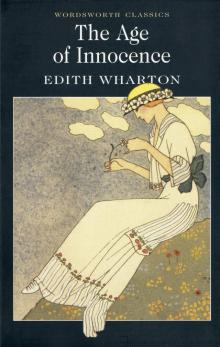 The Age of Innocence
The Age of Innocence The Reef
The Reef Summer
Summer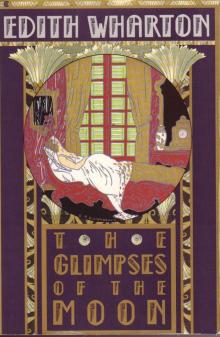 The Glimpses of the Moon
The Glimpses of the Moon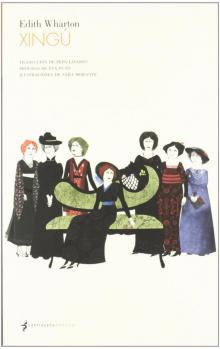 Xingu
Xingu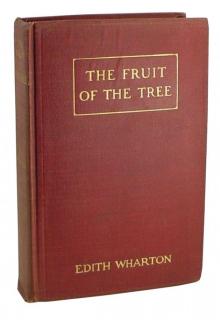 The Fruit of the Tree
The Fruit of the Tree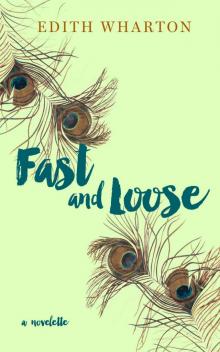 Fast and Loose
Fast and Loose Artemis to Actaeon and Other Verse
Artemis to Actaeon and Other Verse The Line of Least Resistance
The Line of Least Resistance The Lamp of Psyche
The Lamp of Psyche The Reckoning
The Reckoning Afterward
Afterward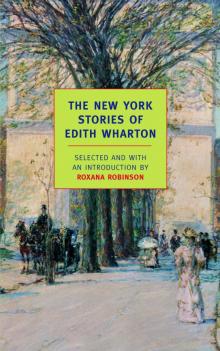 The New York Stories of Edith Wharton
The New York Stories of Edith Wharton The 2014 Halloween Horrors Megapack
The 2014 Halloween Horrors Megapack 'Copy': A Dialogue
'Copy': A Dialogue The Recovery
The Recovery The Fulness of Life
The Fulness of Life Early Short Stories Vol. 1
Early Short Stories Vol. 1 Tales of Men and Ghosts
Tales of Men and Ghosts The House of the Dead Hand
The House of the Dead Hand That Good May Come
That Good May Come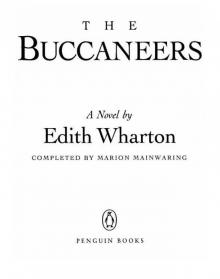 The Buccaneers
The Buccaneers Other Times, Other Manners
Other Times, Other Manners The Hermit and the Wild Woman
The Hermit and the Wild Woman Kerfol
Kerfol The Duchess at Prayer
The Duchess at Prayer Bunner Sisters
Bunner Sisters The Choice
The Choice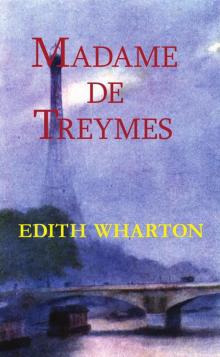 Madame De Treymes
Madame De Treymes Ethan Frome, Summer, Bunner Sisters
Ethan Frome, Summer, Bunner Sisters In Morocco
In Morocco The Valley of Decision
The Valley of Decision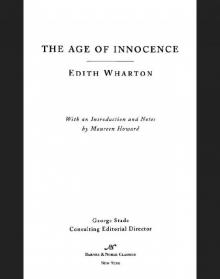 Age of Innocence (Barnes & Noble Classics Series)
Age of Innocence (Barnes & Noble Classics Series) The Angel at the Grave
The Angel at the Grave April Showers
April Showers Sanctuary
Sanctuary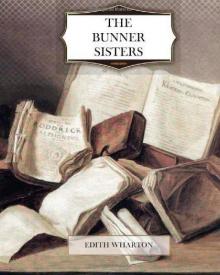 The Bunner Sisters
The Bunner Sisters Mrs. Manstey's View
Mrs. Manstey's View Writing a War Story
Writing a War Story The Custom of the Country
The Custom of the Country In Trust
In Trust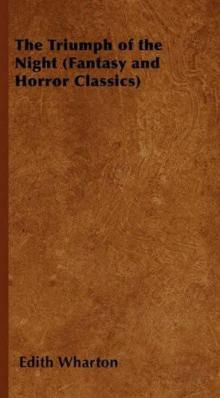 The Triumph of the Night
The Triumph of the Night The Hermit and the Wild Woman, and Other Stories
The Hermit and the Wild Woman, and Other Stories Roman Fever and Other Stories
Roman Fever and Other Stories The Mission of Jane
The Mission of Jane The Descent of Man and Other Stories
The Descent of Man and Other Stories Coming Home
Coming Home The Touchstone
The Touchstone Early Short Stories Vol. 2
Early Short Stories Vol. 2 Edith Wharton's Verse, 1879-1919, from various journals.
Edith Wharton's Verse, 1879-1919, from various journals.